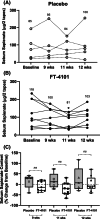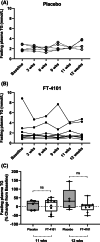Inhibition of fatty acid synthase with FT-4101 safely reduces hepatic de novo lipogenesis and steatosis in obese subjects with non-alcoholic fatty liver disease: Results from two early-phase randomized trials
- PMID: 33289350
- PMCID: PMC7898808
- DOI: 10.1111/dom.14272
Inhibition of fatty acid synthase with FT-4101 safely reduces hepatic de novo lipogenesis and steatosis in obese subjects with non-alcoholic fatty liver disease: Results from two early-phase randomized trials
Abstract
Aims: To assess the therapeutic potential of fatty acid synthase (FASN) inhibition with FT-4101, a potent, selective, orally bioavailable, small-molecule by (a) evaluating the dose-response of single FT-4101 doses (3, 6 and 9 mg) on hepatic de novo lipogenesis (DNL) in healthy participants (Study 1) and (b) demonstrating the safety, tolerability and efficacy on hepatic steatosis after 12 weeks of FT-4101 dosing in patients with non-alcoholic fatty liver disease (NAFLD; Study 2).
Materials and methods: In Study 1, three sequential cohorts of healthy men (n = 10/cohort) were randomized to receive a single dose of FT-4101 (n = 5/cohort) or placebo (n = 5/cohort) followed by crossover dosing after 7 days. Hepatic DNL was assessed during fructose stimulation from 13 C-acetate incorporation. In Study 2, men and women with NAFLD (n = 14) randomly received 12 weeks of intermittent once-daily dosing (four cycles of 2 weeks on-treatment, followed by 1 week off-treatment) of 3 mg FT-4101 (n = 9) or placebo (n = 5). Steady-state DNL based on deuterated water labelling, hepatic steatosis using magnetic resonance imaging-proton density fat fraction and sebum lipids and circulating biomarkers were assessed.
Results: Single and repeat dosing of FT-4101 were safe and well tolerated. Single FT-4101 doses inhibited hepatic DNL dose-dependently. Twelve weeks of 3 mg FT-4101 treatment improved hepatic steatosis and inhibited hepatic DNL. Decreases in sebum sapienate content with FT-4101 at week 11 were not significant compared to placebo and rebounded at week 12. Biomarkers of liver function, glucose and lipid metabolism were unchanged.
Conclusions: Inhibition of FASN with 3 mg FT-4101 safely reduces hepatic DNL and steatosis in NAFLD patients.
Keywords: drug development; drug mechanism; fatty liver disease; pharmacodynamics; phase I−II study; randomized trial.
© 2020 The Authors. Diabetes, Obesity and Metabolism published by John Wiley & Sons Ltd.
Conflict of interest statement
PS, EW, JB, MR, PK are employees and shareholders of Forma Therapeutics. WL and KD were employees of Forma Therapeutics at the time of contribution. CB receives consultancy fees from Forma Therapeutics and ProSciento, Inc. TER is an employee of Celerion. LM received consultancy fees from ProSciento, Inc. MH is an employee and shareholder of ProSciento, Inc. MKH and KL are employees of UCB. MKH receives consultancy fees from Forma Therapeutics. LJ is an employee and shareholder of Antaros Medical.
Figures





Similar articles
-
Acetyl-coenzyme A carboxylase inhibition reduces de novo lipogenesis in overweight male subjects: A randomized, double-blind, crossover study.Hepatology. 2017 Aug;66(2):324-334. doi: 10.1002/hep.29246. Epub 2017 Jul 5. Hepatology. 2017. PMID: 28470676 Free PMC article. Clinical Trial.
-
Insulin resistance drives hepatic de novo lipogenesis in nonalcoholic fatty liver disease.J Clin Invest. 2020 Mar 2;130(3):1453-1460. doi: 10.1172/JCI134165. J Clin Invest. 2020. PMID: 31805015 Free PMC article. Clinical Trial.
-
Acetyl-CoA Carboxylase Inhibitor GS-0976 for 12 Weeks Reduces Hepatic De Novo Lipogenesis and Steatosis in Patients With Nonalcoholic Steatohepatitis.Clin Gastroenterol Hepatol. 2018 Dec;16(12):1983-1991.e3. doi: 10.1016/j.cgh.2018.04.042. Epub 2018 Apr 26. Clin Gastroenterol Hepatol. 2018. PMID: 29705265
-
Role of Dietary Fructose and Hepatic De Novo Lipogenesis in Fatty Liver Disease.Dig Dis Sci. 2016 May;61(5):1282-93. doi: 10.1007/s10620-016-4054-0. Epub 2016 Feb 8. Dig Dis Sci. 2016. PMID: 26856717 Free PMC article. Review.
-
Pharmacologic inhibition of lipogenesis for the treatment of NAFLD.J Hepatol. 2024 Feb;80(2):362-377. doi: 10.1016/j.jhep.2023.10.042. Epub 2023 Nov 15. J Hepatol. 2024. PMID: 37977245 Free PMC article. Review.
Cited by
-
Mechanism of Metabolic Dysfunction-associated Steatotic Liver Disease: Important role of lipid metabolism.J Clin Transl Hepatol. 2024 Sep 28;12(9):815-826. doi: 10.14218/JCTH.2024.00019. Epub 2024 Sep 3. J Clin Transl Hepatol. 2024. PMID: 39280069 Free PMC article. Review.
-
What's New in the Treatment of Non-Alcoholic Fatty Liver Disease (NAFLD).J Clin Med. 2023 Feb 26;12(5):1852. doi: 10.3390/jcm12051852. J Clin Med. 2023. PMID: 36902639 Free PMC article. Review.
-
Deletion of Tfap2a in hepatocytes and macrophages promotes the progression of hepatocellular carcinoma by regulating SREBP1/FASN/ACC pathway and anti-inflammatory effect of IL10.Cell Death Dis. 2025 Apr 3;16(1):245. doi: 10.1038/s41419-025-07500-8. Cell Death Dis. 2025. PMID: 40180937 Free PMC article.
-
Rho-Kinase as a Therapeutic Target for Nonalcoholic Fatty Liver Diseases.Diabetes Metab J. 2021 Sep;45(5):655-674. doi: 10.4093/dmj.2021.0197. Epub 2021 Sep 30. Diabetes Metab J. 2021. PMID: 34610720 Free PMC article. Review.
-
Hypoxia-Inducible Factors as Key Players in the Pathogenesis of Non-alcoholic Fatty Liver Disease and Non-alcoholic Steatohepatitis.Front Med (Lausanne). 2021 Oct 6;8:753268. doi: 10.3389/fmed.2021.753268. eCollection 2021. Front Med (Lausanne). 2021. PMID: 34692739 Free PMC article. Review.
References
-
- Hellerstein MK. De novo lipogenesis in humans: metabolic and regulatory aspects. Eur J Clin Nutr. 1999;53(Suppl 1):S53‐S65. - PubMed
Publication types
MeSH terms
Substances
LinkOut - more resources
Full Text Sources
Medical
Miscellaneous

